Build upper body strength for functional mobility and a toned physique!!
When it comes to bulking, the upper body receives prime attention. Whether biceps, triceps, chest, or back muscle, build your upper body and you can enjoy higher fitness levels with dashing looks.
It’s not just about looking good. A stronger upper body contributes to a better workout too.
However, these are just a few of the benefits of building a stronger upper body. There’s much more to it.
This blog shares every detail on how to build upper body strength. But why do you even care? So, let’s first find out how upper body strength can support your overall well-being.
Upper Body Strength: Why is It Important?

A strong upper body isn’t just about lifting heavy weights. Well, people emphasize building stronger legs and a well-defined core.
However, for a perfect physique and greater fitness level, training your upper body is important.
Here are a few reasons why upper body strength can become an ace for you.
#1. Benefits Cardiac Health
Weight lifting isn’t just about pumping muscles. According to American Heart Association, resistance workouts like powerlifting and weightlifting benefit cardiac health.
Surprisingly, the benefits are similar even with little weight or resistance.
#2. Improves Posture
A stronger upper body makes a stronger back and a solid chest. It naturally improves body function.
While weight training adds muscles, upper body strength prevents slouching to improve your posture.
#3. Less Risk of Injury
Most workouts utilize your arms, chest, shoulder, and back. A low strength level increases the risk of the body getting injured during a move.
In contrast, resistance training builds upper body strength to lessen the risk and even severity of musculoskeletal injury.
#4. Better Workouts
A stronger body makes training effortless. Particularly, building upper body strength makes performing other workouts easier.
For instance, with stronger arms and shoulders, performing push up is no more trouble.
#5. Protect Bones
With aging bones begin to lose strength. Calcium is great for building bone strength, but strength training is equally beneficial.
According to experts, resistance training improves bone density and bone health.
Apart from these, greater upper body strength just makes you feel better. Strength building improves your fitness level, and it reflects in the way you move.
Performing workouts becomes easier, and bone health, cardiac health, and posture improve. It naturally makes you feel better.
Of course, the internet is full of upper-body strength-building workouts, but some exercises are more effective.
5 Useful Tips to Build Upper Body Strength
Mindless weightlifting won’t develop bodily strength. Building strength is just about the right mechanism.
So, it is vital to know how and what can be done to upper body strength.
Here are some tips that can be useful for you in building upper body strength.
#1. It is Not About Weights but Endurance
Building strength is an approach to adapting your muscle against external force. Weight lifting will cause muscle damage for muscle growth only.
Instead, letting your muscle ensure a specific weight for maximum duration would develop strength.
The key is to opt for lightweight and light resistance for a long duration.
#2. The Right Workout is the Best Approach
Go for a resistance workout that works for you. This is the first thing when it comes to strength workouts.
Choose exercises involving dumbbells, machines, resistance bands, or body weight, whichever works for you.
There are so many options, but observe what works for your body. Try to perform those upper-body resistance exercises.
#3. Pay Attention to Other Aspects of Your Workout
When performing strength workouts, pay attention to posture and form during the workout.
Not only do they determine the impact of the particular move, but also cut down the possibility of injury.
In terms of strength, building endurance works side by side with good posture and form.
#4. Breaking Plateau
In terms of resistance training, usually folks go for lighter weights and build endurance with it.
Once the muscle adapts to a particular weight, it means you have achieved a new plateau. It is time to switch to a heavier weight.
#5. Enough Rest and Sleep
Consistency is necessary for building upper body strength. Try to have 2 to 3 resistance workout sessions a week at minimum. Never go do workouts daily. Any kind of training program exhausts you physically.
Thus, the body requires time to recover.
Sleep for 6 to 8 hours minimum daily to provide adequate time for your body to recover. Moreover, take rest for 2 days a week, scheduling them in-between workout days.
Apart from the above tips, it is important to warm up before beginning the upper body strength-building workouts.
Do stretching works or simple easy-going moves to get started. Perform at minimum 5 sets of 12 to 15 reps of each workout.
To gain upper body strength, some workouts are anyhow more effective. In the next segment, find the best upper body strength-building exercises.
6 Workouts for Greater Upper Body Strength
Generally, the workouts emphasize developing upper body strength.
However, at the same time, the exercises refine the shape of the muscle tissue to tone them up. On top of that, they even add some quality lean muscles.
Here are top upper body workouts for strength.
#1. Chest Press
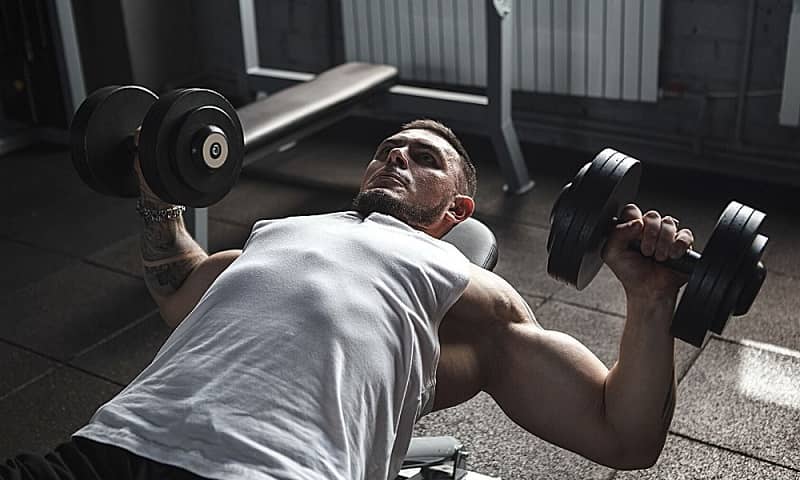
Though the workout aims to strengthen the upper body, it even aids the lower body. The move specifically works on your arms and shoulders.
It requires weight to execute making the right form important.
Here’s how to perform the chest press.
- Lay down on a flat bench while holding weights in both hands. Knees should be at a 90-degree and your feet in the air.
- Uplift the weight above your chest as you breathe out until your elbows are straight. Maintain the posture for a couple of seconds.
- Inhale while you bring the weight to the initial position
Maintain a proper form during the entire movement. Also, in the beginning, start with the least weight as per your comfort.
#2. Front and Lateral Arm Raise
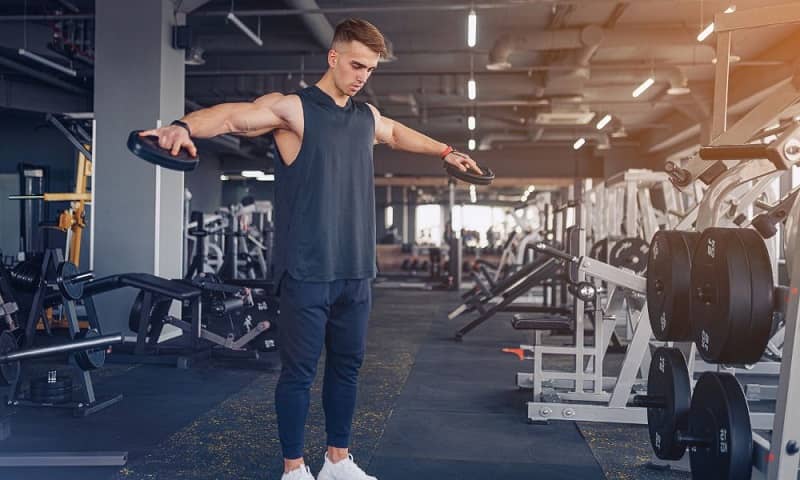
The upper body exercise builds strength as well as develops the biceps.
However, the weight is lighter, so the difference in the biceps won’t be noteworthy enough. Still, it would tone your arms muscle.
Here’s how to do front and lateral arm raise.
- Begin in a standing posture keeping your feet at shoulder width. Meanwhile, keep a dumbbell in both hands.
- Uplift the weights in the hands in front of you until it reaches shoulder height. Get back to the initial posture.
- Now, lift weights to both sides as if forming the shape of T. return to the initial position. This is one rep.
The movement lasts longer so don’t go overboard. Begin with minimum weights. Also, reps and sets depend on individual preferences.
#3. Push-Up on Ball
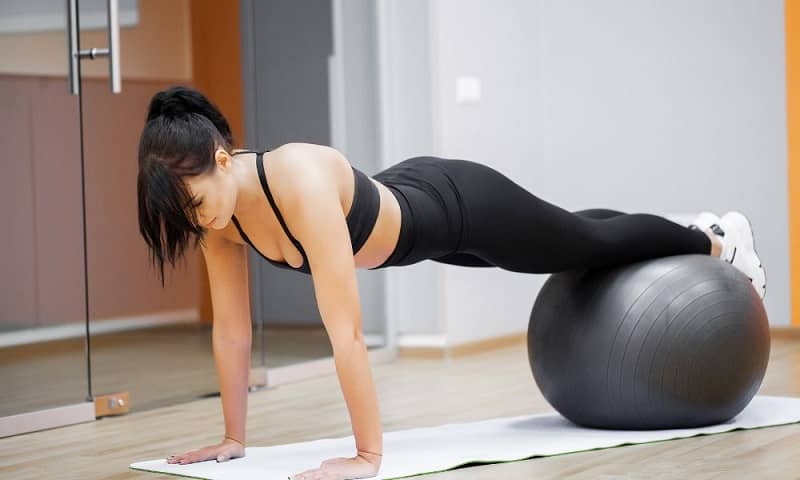
The push-up variation adds resistance through the use workout ball. However, when performing the move, pay attention to stability. Don’t haste while performing the move.
Here’s how to do push-ups on a ball:
- Keep your feet on the stability ball and get into a push-up position.
- Breathe out as you bend your elbows to lower your body to the ground.
- Breathe in as you uplift the body to the initial position. This is one rep.
You can try other push-up varieties if you aren’t comfortable performing. Look how the arms move to maintain the right form and to build explosive upper body strength.
ALSO READ: 15 Ab Exercises for Women
#4. Bench Dip
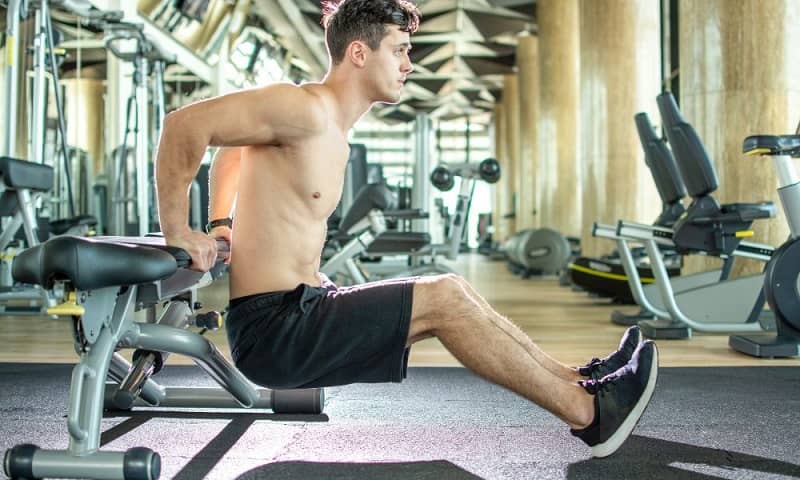
The upper body workout requires strong arms. Thus, beginners should avoid performing the workouts. It requires a stability ball and a bench to execute the move.
Here’s how to do a bench dip.
- Keep your feet on a stability ball. Hold the edge of a bench with your palms while your fingers face forward. Now, raise your bottom in the air.
- As you breathe out, drop your body down while bending your elbows.
- Breathe in and straighten your arms to return to the initial position. When performing the movement, your glutes and core should remain tight.
When performing the upper body exercise, keep your legs straight. Moreover, pay attention to the form of your arms.
#5. Bicep Curl
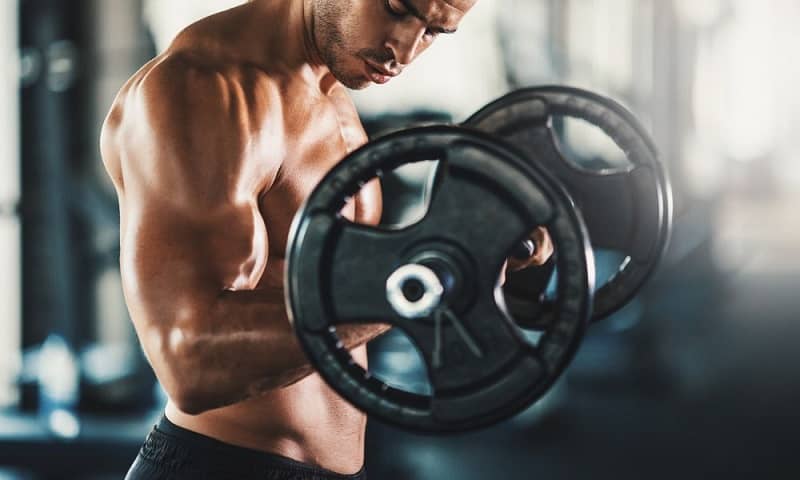
The movement utilizes weights to build upper body strength. Clear from the work, the exercise emphasis on biceps. So, doing a few extra reps would only benefit your arm muscle.
Here’s how to perform biceps curls.
- Stand at a shoulder-width distance. Keep a dumbbell in each hand while the palms should face forward.
- Contract your biceps to lift weight in your right hand to your shoulder. Return to the initial position.
- Do the same movement on the left side. This is one rep.
It is a super easy workout, but don’t rush. See how your biceps move, do it slowly to build strength and get a bigger upper body at home.
#6. Plank Row
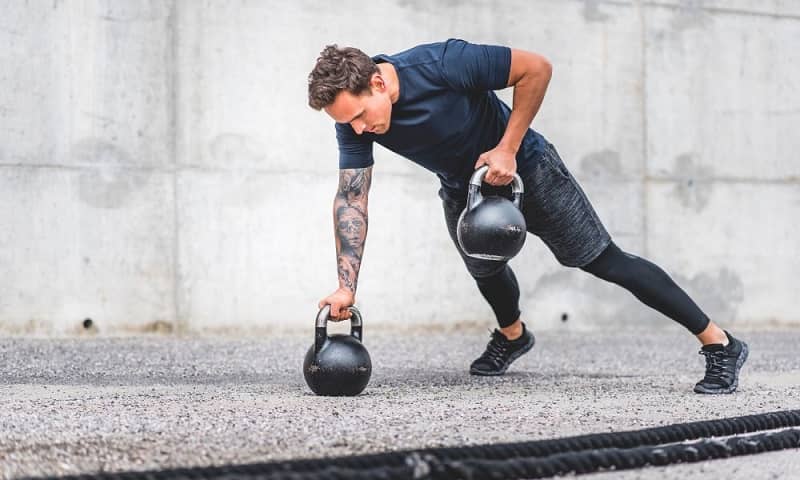
It is a variation of the normal plank to provide more resistance to build upper body strength.
On top of that, it even helps build the core and lower body to a great extent.
Here’s how to do plank row:
- Get into a push-up posture keeping weight in each hand. Your legs should remain at shoulder width distance.
- Without moving your lower body, engage the core to raise one weight off the ground as your below raise toward the ceiling.
- Bring the weight back to the ground and stay in the plank posture. Repeat the same move on the other side. This is one rep.
When performing the workout, your legs should remain straight. Beginners should first learn to do a plank before doing this variation of the plank.
Only doing the workouts with weight or without weights won’t work, but knowing how to properly perform the exercise help build upper body strength.
Also, perform what you think works best for your fitness objective.
The exercises play a decisive role in building upper body strength.
However, the training program takes a specific duration to show results. We will get into the details.
How Long Does It Take To Build Upper Body Strength?
It depends on lots of factors like your current stats, the resistance-training program, consistency, diet, age, and more.
Particularly, the type of strength training workout and effort matter most.
Nonetheless, the initial difference is visible within the first 12 weeks.
The figurative suggestion is based on 2 to 3 upper body days per week. Of course, the duration is representational, it can vary from individual to individual.
The craze of building upper body strength has gone up these days. However, emphasizing one part of the body has implications.
Warning: What If You Only Exercise Your Upper Body?
Training one part of the body can improve it, there is no doubt about that. But at the same time avoiding other muscle groups can have harsh complications.
It can particularly lead to muscle imbalance. On top of that, it is highly likely to injure muscle mass, tendons, or bone.
Also, an over-trained upper body would require more time to recover. The muscle soreness would be also there.
At the same time, avoiding different muscle groups will weaken them. It would specifically weaken joints and ligaments in that particular area.
How you approach the upper body strength program matters if the goal is to develop strength. This blog covered every necessary detail. It is time to jot down important points of the discussion.
Takeaway!
Greater muscular strength can give the edge to your entire training program.
Developing upper body strength is more beneficial because most workouts utilize the upper body to perform the move.
On top of that, the benefits are many like greater cardiac health, better posture, stronger bone, and fewer injuries. However, the advantages are visible only when the approach is right.
Don’t over-train the upper body. 2 to 3 strength-training sessions a week are more than enough.
When working on the upper body, don’t ignore other body parts, it would lead to problems as discussed.
Still got doubts about the upper body strength program? Ask in the comment section!